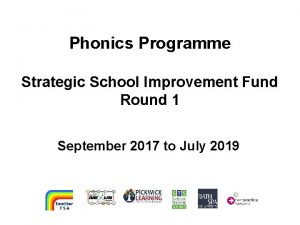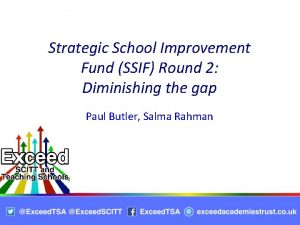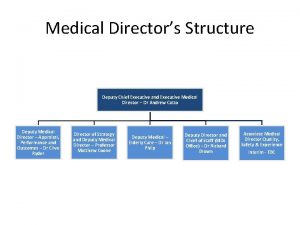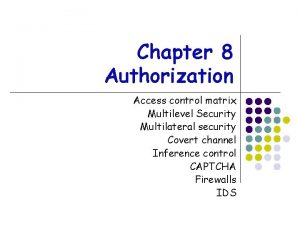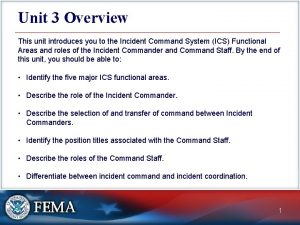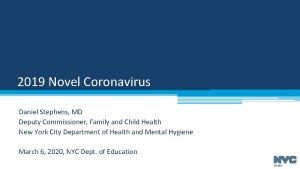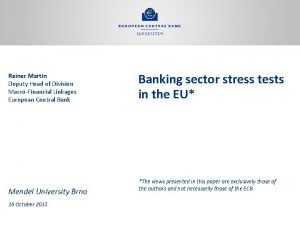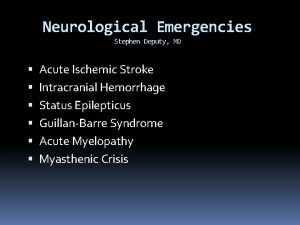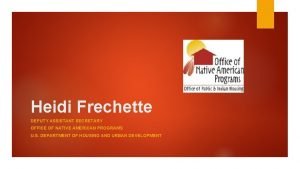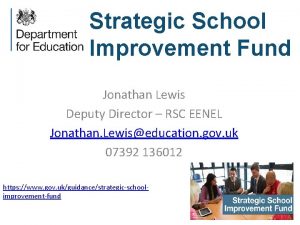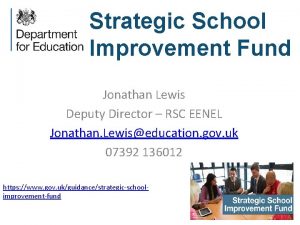Strategic School Improvement Fund Jonathan Lewis Deputy Director




















- Slides: 20

Strategic School Improvement Fund Jonathan Lewis Deputy Director – RSC EENEL Jonathan. Lewis@education. gov. uk 07392 136012 https: //www. gov. uk/guidance/strategic-schoolimprovement-fund

Our Collective Vision for a Changing Educational World • The 5 key drivers that have to inform our “north star” thinking – More good school places in the system for all children – Doing even better with a smaller resource – The role that education plays in the social mobility agenda – Recognition that a more diverse system means a new relationship with Maintained schools, Academies, FS, UTC, Studio Schools, Diocesan Schools, small rural schools, independent schools, Universities and selective schools – Shift from conversion to conversion + Improvement East of England North East London Region

East of England North East London – Delivering the ‘Miracle in the East’ – 2017 School Improvement Focus Providing support and challenge to Teaching Schools and commissioning school improvement • Support developing new Teaching Schools in 'cold spots' in the region • Develop programmes to support key challenge areas - phonics, disadvantaged groups, KS 2 assessment • Developing a robust process for commissioning of school improvement in partnership with TSA including accountability measures Supporting Recruitment and Retention of the highest quality teachers across the region. • Engage with Academy Trusts, Local Authorities and the wider department to develop a innovate strategy to improve recruitment and retention in the most challenging parts of the region. • Ensure a high quality CPD offer is available through teaching schools and strategic partners to all schools in the region for improving all teaching to at least good. Promoting improved outcomes in Maths across all phases • Support the implementation of the Teaching for Mastery programme and ensure those schools where outcomes are historically low are proritised. • Hold a conference on improving Maths in conjunction with teaching schools and Ofsted Continue to target schools which are underperforming and implement rapid improvement • Use our powers of intervention rapidly and appropriately to bring around whole school improvement and target areas of underpeformance spatially. • Continue to undertake Education Advisor visits at schools which are not yet considered to be good. • Ensure robust plans are in place for rapid improvement in Coasting Schools Focus on outcomes at KS 5 and transition • Provide support and challenge to the Area Based Review across the Region to ensure effective learning pathways are developed. • Target all schools which are underperforming at KS 5, issuing warning notices where performance is unacceptably low.

What does a School Led system look like in the future? • What kind of education system should we be aiming to create? – Every child has access to a good school – Every school is a giver and receiver of support – Every school is part of a formal collaboration that develops “next” practice and research potential – Teachers, leaders and support staff have a 10 year career plan that is realistic and deliverable – Governance will be world class and we can name it and describe it

Health Warning • Everything I might tell you could change • New tenure of the Secretary of State, funding concerns and priorities may alter So why tell us? • We want you to be ready and understand…. this is all about you improving schools. • The fund is now open and we are welcoming applications

Strategic School Improvement Fund - Introduction • On the 30 November 2016 the Secretary of State announced new funding for school improvement; this included a Strategic School Improvement Fund (the Fund) aimed at ensuring resources are targeted at the schools most in need of support to drive up standards, use their resources most effectively and deliver more good school places. • This fund is a £ 140 million per year grant over two financial years (April 2017 to March 2019) and there will be multiple funding rounds from summer 2017 through to spring 2018. • Alongside the Fund, the Education Endowment Foundation has pledged up to £ 20 million to further evaluate the impact of a selection of proposals with a view to disseminating practice and supplementing its toolkit of evidence-based interventions. • Round One of the fund is now OPEN and more information can be found on: https: //www. gov. uk/guidance/strategic-schoolimprovement-fund

Principles underpinning the Fund Sustainable improvement – not a quick fix Evidence based interventions that work Social mobility will be at the heart of how the Fund operates Addressing shared and often entrenched priorities for all types of schools Effective support directed at the right schools

Overview • Teaching schools, local authorities and multi-academy trusts will submit applications for funding which address strategic improvement needs across a locality e. g. boys writing in local authority X, or financial efficiency of rural primary schools in Y, or maths attainment in a defined group of schools across an area. • Applications will set out detailed proposals of what needs to be improved, how it will be improved and what the outcomes / impact and costs will be. • Improvement activities set out in the application must have a sound evidence-base of success; or, for more innovative approaches, a clear rationale for why they will lead to improvement. • Application values will typically be in the range of £ 100, 000 to £ 500, 000 and will provide improvement support to a minimum of four schools, and ideally more.

How will funding be directed to where it’s needed most? • The Fund provides the opportunity for those organisations in the system with a common interest in improving outcomes for children through school-led support to come together to develop proposals which address need irrespective of where a school is, or whether it is an academy or maintained. • To ensure that support reaches those schools which need it most, and in the most effective way, we expect that, in shaping applications, regional schools commissioners (RSC), Teaching Schools Council (TSC), multi-academy trusts (mats), local authorities and diocesan representatives will work collaboratively with schools to bring together their local intelligence to identify shared improvement priorities. • To avoid duplication, we encourage teaching schools to make their Teaching Schools Council regional lead aware of their intention to submit an application(s). Similarly, we encourage multi-academy trusts to make their regional schools commissioner aware of their intention to apply. 9

Who can apply for the Fund? • Teaching schools, multi-academy trusts and local authorities will submit applications on behalf of schools in need of support – we refer to these as ‘applicants’. • Multi-academy trusts can apply to support their own schools, but only when they are also supporting at least one school not in their trust in the same application. • All parties – the applicant, the providers of support and the supported schools – must have given their express approval to the application and its provisions prior to submission. • The Department may seek of draw on further information on applicants and providers in order to confirm their capacity to carry out the activities required for the successful delivery of an application. • An individual application must provide support to at least four schools (All primary, secondary and all-through maintained schools and academies, special schools, and PRUs in England) that meet the eligibility criteria qualify for support with 70% of schools meeting the eligibility criteria.

What are the deadlines for applications? • The fund opened for applications on Friday 21 April 2017 (applicants notified of outcome in August 2017. • The application deadline for round 1 is midday on Friday 23 June. • There will be further funding rounds in autumn 2017, with the round 2 deadline in September, and spring 2018. • Date for future funding rounds will be confirmed in autumn 2017. 11

Application process Step 1 – Submit Applications Step 2 – Df. E undertake eligibility & completeness checks Step 3 – Expert Investment Board Decision Step 4 – Applicant informed / Payment and Delivery Df. E informs applicants of outcomes. Teaching schools, local authorities and multi-academy trust submit online applications to Df. E checks all applications to make sure all fields are completed with valid information, and that they meet the requirements for an eligible application Df. E’s National Expert Investment Board makes recommendations for funding awards Initial grant payments made for successful applications Delivery progresses Applicant returns termly reports to trigger subsequent payments Applicant and Df. E monitor progress of interventions Delivery of activity starts 8 -9 week period Step 5 – Delivery, Reporting and Evaluation Df. E undertake process and impact evaluation

What sort of support interventions do we want to encourage? • We want to encourage applications which improve outcomes for all children, be it through improving teaching and learning, leadership, governance, or by more specific interventions such as those that: – Increase teachers’ capacity to enable them to focus on their teaching and undertake effective, evidence-based professional development. – Specifically focus on raising the attainment of pupils with SEND. In particular, applications which focus on identifying SEND and putting in place effective interventions. – Have a clear impact on the efficiency of schools to support improved financial health and improved pupil outcomes. – Specifically improve the performance of a school in relation to its disadvantaged pupils. – Include targeted interventions to improve governance. • Interventions can be for any length of time and can cross academic years; however, they must be completed by 31 March 2019. Start times will depend on for which round applications are received e. g. a successful application in round 1 will likely start in September 17. 13

What are the eligibility criteria? • We want to direct funding to the schools most in need so we have used criteria already set out in Schools Causing Concern Guidance, and proposed a set of indicators to help identify schools at risk of underperformance. • The main eligibility criteria have limitations. The ‘performance’ indicators are based on published annual data from 15/16 and, therefore, do not act as early warning of in-year risk or very recent risk – for this we will rely on local intelligence from the sector. • To be eligible for support, a school will need to meet one of the main eligibility criteria, or it can be identified from local intelligence. • Of the schools supported through an application, at least 70% of them must meet one or more of the main eligibility criteria; the remaining 30% can be schools identified through local intelligence. 14

Eligibility Criteria At least 70% of the supported schools in any application must meet one or more of the above eligibility criteria. NB exceptions will be made for applications solely in support of special schools. • Schools in opportunity areas • Schools rated inadequate in latest inspection • Schools that meet the coasting definition or schools that are below the floor standard based on their published data • Schools rated requires improvement in 2 consecutive Ofsted inspections • Schools received a warning notice over the past 3 years • Schools not meeting the KS 5 minimum standards • Progress 8 score overall less than -0. 25 • KS 5 academic progress score is between 0 and -0. 5 • KS 5 applied general progress score is between 0 and -0. 75 15

Eligibility Criteria Secondary Disadvantage Schools meet both of these criteria: 1) There are more than 35 disadvantaged pupils in the school, and 2) Progress 8 score for disadvantaged pupils in the school is less than -0. 25 overall Schools meet both of these criteria: 1) There are more than 35 disadvantaged pupils in the school, and 2) The gap between disadvantaged pupils and non-disadvantaged pupils nationally for Progress 8 scores is less than -0. 25 (Please note these are negative numbers so a score that is less than -2. 5 would, for example, be -3. 5 or -5. 5) Primary Disadvantage Schools meet both of these criteria: 1) Less than 85% of pupils overall achieve expected standard in reading, writing and maths, and 2) At least one of the following is true: i) Reading progress is less than -2. 5 , ii) Writing progress is less than -3. 5, iii) Maths progress is less than -2. 5 Schools meet all of these criteria: 1) There are more than 10 disadvantaged pupils in the school, 2) Less than 85% of disadvantaged pupils in the school achieve the expected standard in reading, writing and maths, and 3) At least one of the following is true: i) Reading progress is less than -2. 5, ii) Writing progress is less than -3. 5, iii) Maths progress is less than -2. 5 Schools meet both of these criteria: • There are more than 10 disadvantaged pupils in the school, and • At least one of the following is true: i) The gap between disadvantaged pupils and other pupils nationally for reading is less than -2. 5, ii) The gap between disadvantaged pupils and other pupils nationally for writing is less than -3. 5, iii) The gap between disadvantaged pupils and other pupils nationally for maths is less than -2. 5 (Please note these are negative numbers so a score that is less than -2. 5 would, for example, be -3. 5 or -5. 5) • Norfolk has 167 eligible schools hitting the criteria 333 times 16

Which organisations can provide the support? • We expect teaching schools and national leaders of education in particular to play a major role in delivering the funded support interventions. • Some applicants may also wish to draw on the expertise and specialisms of other proven school improvement / school to school support providers such as, but not limited to, maintained schools, multi-academy trusts, local authorities, higher education institutions, independent schools, charities and not-for-profit organisations as well as private sector providers. • For teaching schools with their designation under review, or likely to be reviewed for reasons that may impact on the successful delivery of the application, we may seek further information to confirm their capacity to carry out the activities. • The applicant will be responsible for quality assuring all provision to ensure the outcomes of applications are achieved.

Emergency fund • In the event of an emergency, we will consider applications to the fund to support an individual school, as opposed to a group of schools, and if the supported school meets the eligibility criteria for emergency funding. • We aim to pay grants for emergency funding applications within 4 weeks of receipt. • Emergency funding is intended to address: • • evidence of unexpected or imminent failure; or • withdrawal of planned/existing support to address failure/imminent failure • failure where other long-term support options are not feasible It is to provide bespoke support, typically at a whole or near whole school level, for an individual school.

How will Df. E assess applications? • A national Expert Investment Board will assess the extent to which applications demonstrate: • An evidenced-based programme of work (how clear is the logic and evidence of how and why the intervention will work? The scale and scope of the forecast impact on achieving improved outcomes for children? ) • Deliverability (how robust is the action plan? How clear are the baseline measures and outcomes? Has the applicant identified the main risks, and how robust are the mitigations to these? Does the application evidence sufficient capacity and capability that the activity can be delivered? Is there a good approach to quality assurance of provision? ) • Sustainability (does the application provide a clear plan as to how interventions will develop a foundation for sustainable improvement, for example, by improving practices and behaviours? ) • Value for money (are the costs clearly set out? Is there evidence that the applicant has taken steps to secure value for money? )

What about Norfolk? • Opportunity Area – impact in Norwich and wider area? • Need to develop further the system leadership capacity in the county – Teaching Schools, NLE, SLE • Effective existing networks ensuring a S 2 SS focus • The system having greater accountability and outcome measurement - are children benefiting?
 Strategic school improvement fund round 3
Strategic school improvement fund round 3 Strategic school improvement fund round 3
Strategic school improvement fund round 3 Ambition school leadership
Ambition school leadership Deputy medical director
Deputy medical director Entries are made to the petty cash account when
Entries are made to the petty cash account when Deputy stowers
Deputy stowers Head girl manifesto speech
Head girl manifesto speech Onondaga county civil deputy
Onondaga county civil deputy Confused deputy
Confused deputy Which ics functional area arranges for resources
Which ics functional area arranges for resources Deputy jody hull
Deputy jody hull David elizalde
David elizalde Daniel stephens md deputy commissioner
Daniel stephens md deputy commissioner Reiner
Reiner Stephen deputy md
Stephen deputy md Deputy manager wikipedia
Deputy manager wikipedia The crucible direct and indirect characterization
The crucible direct and indirect characterization Hud assistant secretary
Hud assistant secretary Strategic fit vs strategic intent
Strategic fit vs strategic intent Strategy
Strategy Io model strategic management
Io model strategic management
